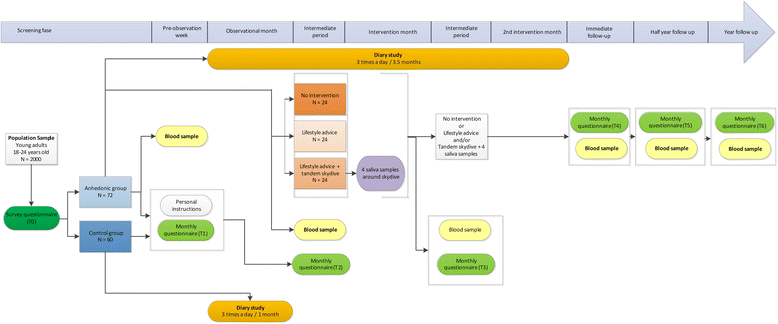Study protocol for a randomized controlled trial to explore the effects of personalized lifestyle advices and tandem skydives on pleasure in anhedonic young adults
- PMID: 27260011
- PMCID: PMC4893264
- DOI: 10.1186/s12888-016-0880-z
Study protocol for a randomized controlled trial to explore the effects of personalized lifestyle advices and tandem skydives on pleasure in anhedonic young adults
Abstract
Background: Anhedonia is generally defined as the inability to feel pleasure in response to experiences that are usually enjoyable. Anhedonia is one of the two core symptoms of depression and is a major public health concern. Anhedonia has proven particularly difficult to counteract and predicts poor treatment response generally. It has often been hypothesized that anhedonia can be deterred by a healthy lifestyle. However, it is quite unlikely that a one-size-fits-all approach will be effective for everyone. In this study the effects of personalized lifestyle advice based on observed individual patterns of lifestyle behaviors and experienced pleasure will be examined. Further, we will explore whether a tandem skydive following the personalized lifestyle advice positively influences anhedonic young adults' abilities to carry out the recommended lifestyle changes, and whether this ultimately improves their self-reported pleasure.
Methods: Our study design is an exploratory intervention study, preceded by a cross-sectional survey as a screening instrument. For the survey, 2000 young adults (18-24 years old) will be selected from the general population. Based on survey outcomes, 72 individuals (36 males and 36 females) with persistent anhedonia (i.e., more than two months) and 60 individuals (30 males and 30 females) without anhedonia (non-anhedonic control group) will be selected for the intervention study. The non-anhedonic control group will fill out momentary assessments of pleasure and lifestyle behaviors three times a day, for one month. The anhedonic individuals will fill out momentary assessments for three consecutive months. After the first month, the anhedonic individuals will be randomly assigned to (1) no intervention, (2) lifestyle advice only, (3) lifestyle advice plus tandem skydive. The personalized lifestyle advice is based on patterns observed in the first month.
Discussion: The present study is the first to examine the effects of a personalized lifestyle advice and tandem skydive on pleasure in anhedonic young adults. Results of the present study may improve treatment for anhedonia, if the interventions are found to be effective.
Trial registration: Dutch Trial Register, NTR5498 , registered September 22, 2015 (retrospectively registered).
Keywords: Anhedonia; Intervention; Personalized lifestyle advice; Randomized controlled trial; Tandem skydive; Young adults.
Similar articles
-
Alpha-amylase reactivity and recovery patterns in anhedonic young adults performing a tandem skydive.PLoS One. 2018 Sep 24;13(9):e0204556. doi: 10.1371/journal.pone.0204556. eCollection 2018. PLoS One. 2018. PMID: 30248153 Free PMC article.
-
An Exploratory Randomized Controlled Trial of Personalized Lifestyle Advice and Tandem Skydives as a Means to Reduce Anhedonia.Behav Ther. 2017 Jan;48(1):76-96. doi: 10.1016/j.beth.2016.09.009. Epub 2016 Oct 8. Behav Ther. 2017. PMID: 28077223 Clinical Trial.
-
Personalized lifestyle advice alters affective reactivity to negative events in anhedonic young adults.J Affect Disord. 2021 Aug 1;291:118-125. doi: 10.1016/j.jad.2021.04.036. Epub 2021 Apr 27. J Affect Disord. 2021. PMID: 34029882
-
Anhedonia in Depressive Disorder: A Narrative Review.Psychopathology. 2020;53(5-6):274-281. doi: 10.1159/000508773. Epub 2020 Jul 15. Psychopathology. 2020. PMID: 32668436 Review.
-
Conceptualizing anhedonias and implications for depression treatments.Psychol Res Behav Manag. 2019 May 13;12:325-335. doi: 10.2147/PRBM.S159260. eCollection 2019. Psychol Res Behav Manag. 2019. PMID: 31191054 Free PMC article. Review.
Cited by
-
Alpha-amylase reactivity and recovery patterns in anhedonic young adults performing a tandem skydive.PLoS One. 2018 Sep 24;13(9):e0204556. doi: 10.1371/journal.pone.0204556. eCollection 2018. PLoS One. 2018. PMID: 30248153 Free PMC article.
-
Reward and punishment learning in daily life: A replication study.PLoS One. 2017 Oct 4;12(10):e0180753. doi: 10.1371/journal.pone.0180753. eCollection 2017. PLoS One. 2017. PMID: 28976985 Free PMC article. Clinical Trial.
-
Affective family interactions and their associations with adolescent depression: A dynamic network approach.Dev Psychopathol. 2018 Oct;30(4):1459-1473. doi: 10.1017/S0954579417001699. Epub 2017 Nov 20. Dev Psychopathol. 2018. PMID: 29151387 Free PMC article.
-
Lower Sensitivity to Happy and Angry Facial Emotions in Young Adults with Psychiatric Problems.Front Psychol. 2016 Nov 22;7:1797. doi: 10.3389/fpsyg.2016.01797. eCollection 2016. Front Psychol. 2016. PMID: 27920735 Free PMC article.
References
-
- Spijker J, Bijl RV, De Graaf R, Nolen WA. Determinants of poor 1-year outcome of DSM-III-R major depression in the general population: results of the Netherlands Mental Health Survey and Incidence Study (NEMESIS) Acta Psychiatr Scand. 2001;103:122–30. doi: 10.1034/j.1600-0447.2001.103002122.x. - DOI - PubMed
MeSH terms
Associated data
LinkOut - more resources
Full Text Sources
Other Literature Sources
Medical


